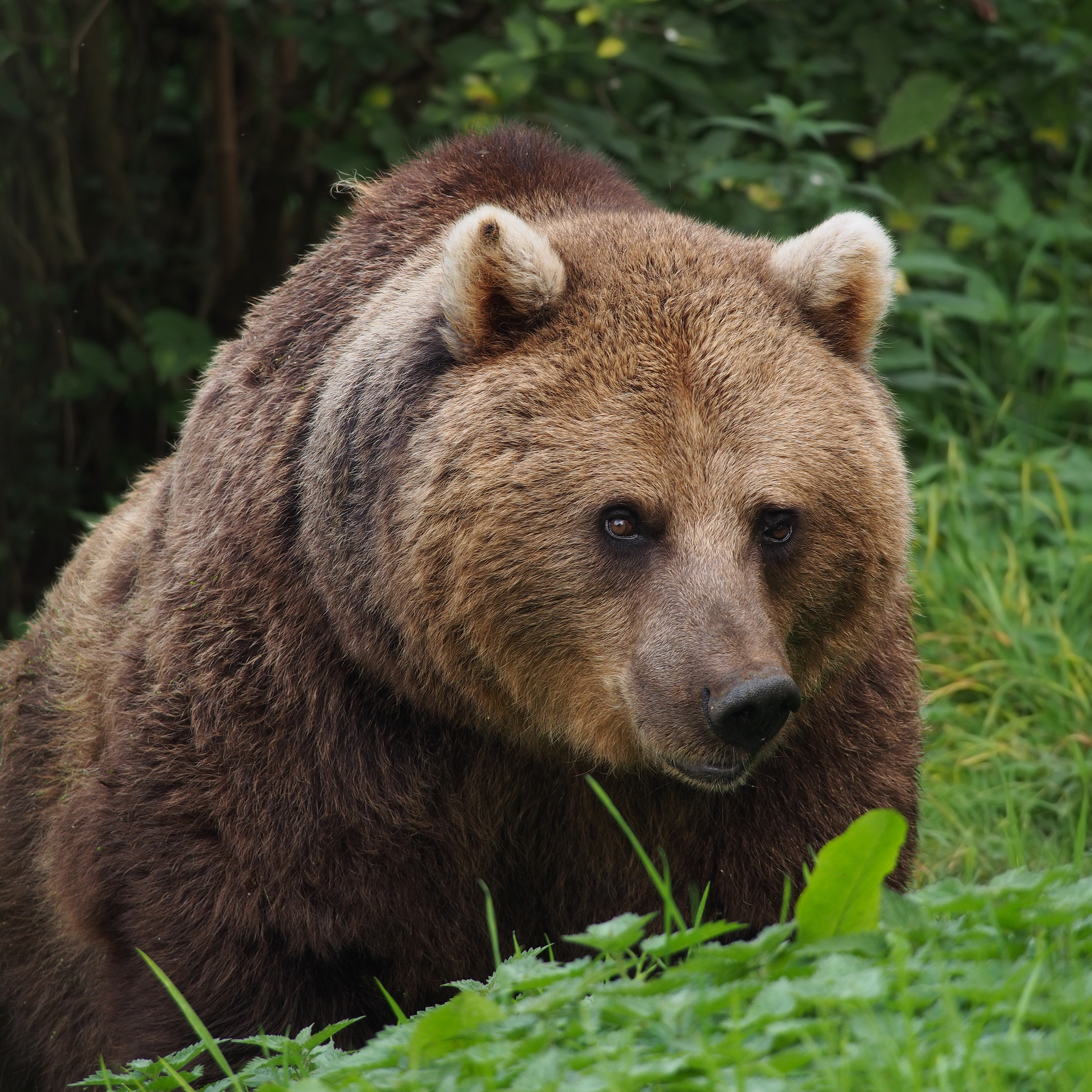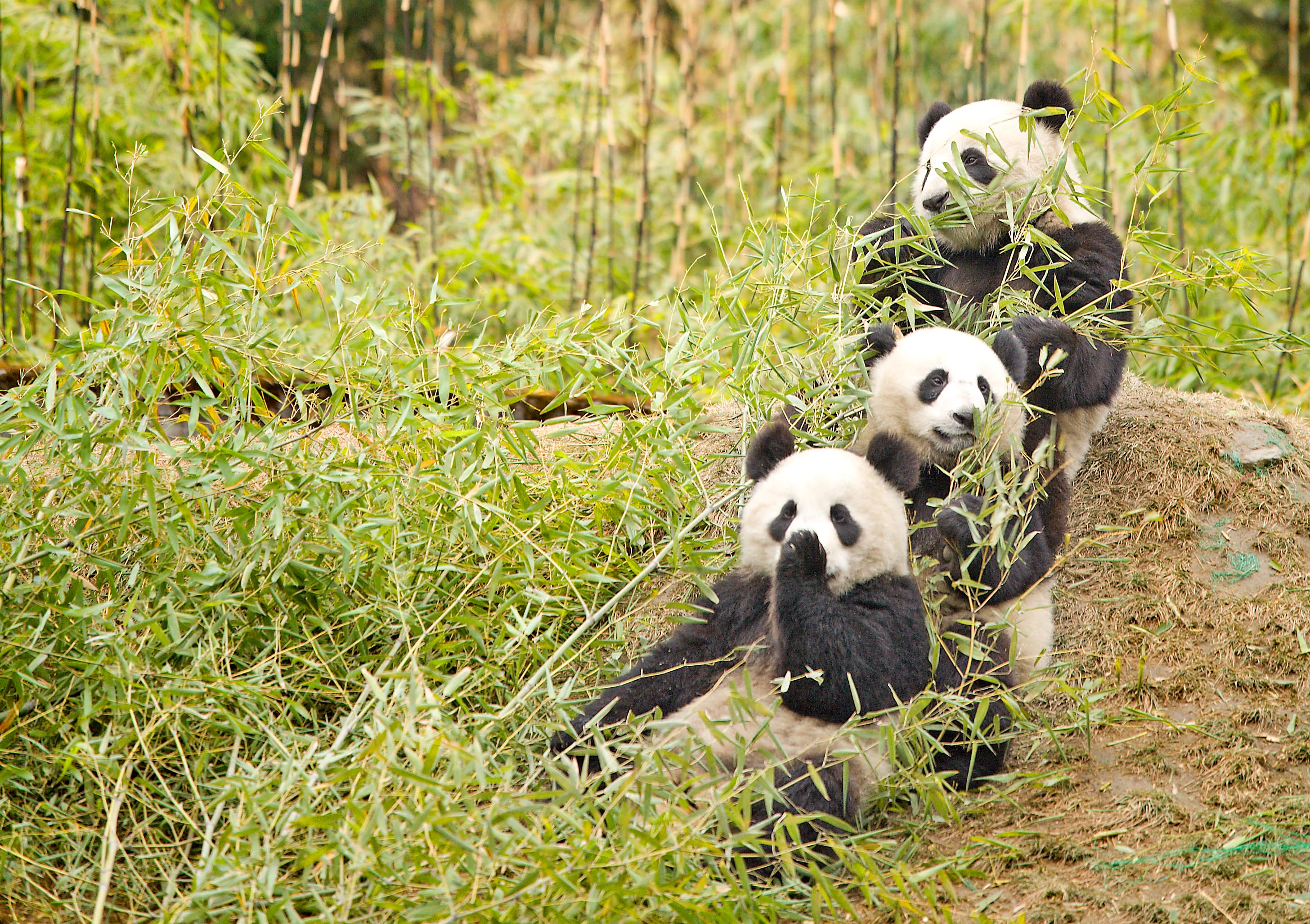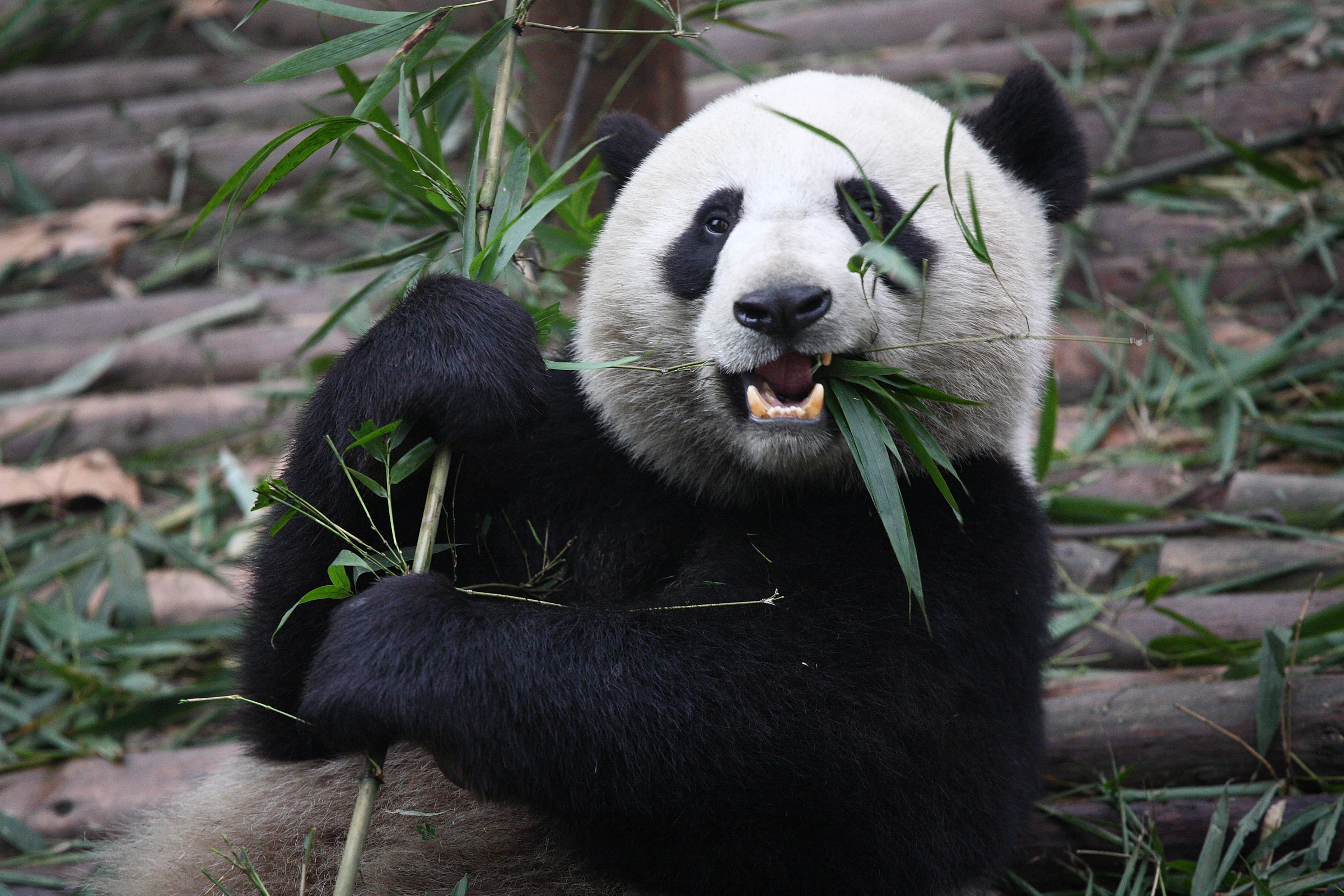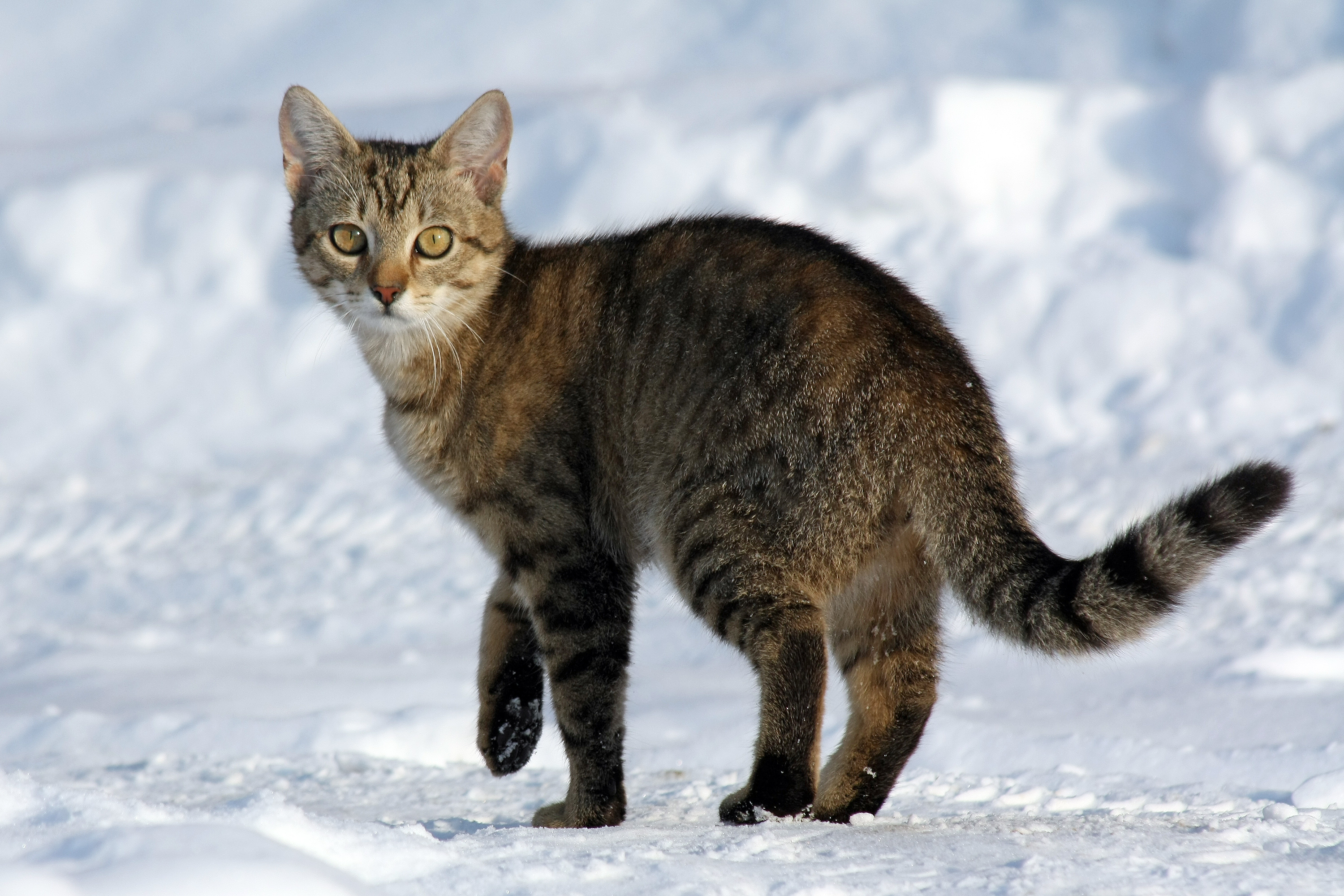|
Ursidae
Bears are carnivoran mammals of the family (biology), family Ursidae (). They are classified as caniforms, or doglike carnivorans. Although only eight species of bears are extant, they are widespread, appearing in a wide variety of habitats throughout most of the Northern Hemisphere and partially in the Southern Hemisphere. Bears are found on the continents of North America, South America, and Eurasia. Common characteristics of modern bears include large bodies with stocky legs, long snouts, small rounded ears, shaggy hair, plantigrade paws with five nonretractile claws, and short tails. While the polar bear is mostly carnivorous, and the giant panda is mostly herbivorous, the remaining six species are omnivorous with varying diets. With the exception of courtship display, courting individuals and mothers with their young, bears are typically solitary animals. They may be diurnality, diurnal or nocturnal and have an excellent sense of smell. Despite their heavy build and awk ... [...More Info...] [...Related Items...] OR: [Wikipedia] [Google] [Baidu] |
Brown Bear
The brown bear (''Ursus arctos'') is a large bear native to Eurasia and North America. Of the land carnivorans, it is rivaled in size only by its closest relative, the polar bear, which is much less variable in size and slightly bigger on average. The brown bear is a sexually dimorphic species, as adult males are larger and more compactly built than females. The fur ranges in color from cream to reddish to dark brown. It has evolved large hump muscles, unique among bears, and paws up to wide and long, to effectively dig through dirt. Its teeth are similar to those of other bears and reflect its Dietary biology of the brown bear, dietary plasticity. Throughout the brown bear's range, it inhabits mainly forest, forested habitats in elevations of up to . It is omnivorous, and consumes a variety of plant and animal species. Contrary to popular belief, the brown bear derives 90% of its diet from plants. When hunting, it will target animals as small as insects and rodents to thos ... [...More Info...] [...Related Items...] OR: [Wikipedia] [Google] [Baidu] |
Tremarctinae
The Tremarctinae or short-faced bears is a subfamily of Ursidae that contains one living representative, the spectacled bear (''Tremarctos ornatus'') of South America, and several extinct species from four genera: the Florida spectacled bear (''Tremarctos floridanus''), the North American giant short-faced bears '' Arctodus'' (''A. pristinus'' and ''A. simus''), the South American giant short-faced bear ''Arctotherium'' (including ''A. angustidens'', ''A. vetustum'', ''A. bonariense'', ''A. wingei'', and ''A. tarijense)'' as well as '' Plionarctos'' ''(P. edensis and P. harroldorum),'' which is thought to be ancestral to the other three genera. Of these, the giant short-faced bears ('' Arctodus simus'' and '' Arctotherium angustidens'') may have been the largest ever carnivorans in the Americas. The group is thought to have originated in eastern North America, and then invaded South America as part of the Great American Interchange. Most short-faced bears became extinct at th ... [...More Info...] [...Related Items...] OR: [Wikipedia] [Google] [Baidu] |
Ailuropodinae
Ailuropodinae is a subfamily of Ursidae that contains only one extant species, the giant panda (''Ailuropoda melanoleuca'') of China. The fossil record of this group has shown that various species of pandas were more widespread across the Holarctic, with species found in places such as Europe, much of Asia, North America and even Africa. The earliest pandas were not unlike other modern bear species in that they had an omnivorous diet but by around 2.4 million years ago, pandas had evolved to be more herbivorous. The giant panda (''Ailuropoda'') belongs to the order of Carnivora, this means that the macronutrients that are digested are most similar to those of carnivores than to that of herbivores even though their diet consists mainly of bamboo. Systematics Ever since the giant panda was first described to science, they have been a source of taxonomic confusion, having been variously classified as a member of Procyonidae, Ursidae, Ailuridae, or even their own family Ailuropo ... [...More Info...] [...Related Items...] OR: [Wikipedia] [Google] [Baidu] |
Giant Panda
The giant panda (''Ailuropoda melanoleuca''), also known as the panda bear or simply panda, is a bear species endemic to China. It is characterised by its white animal coat, coat with black patches around the eyes, ears, legs and shoulders. Its body is rotund; adult individuals weigh and are typically long. It is sexually dimorphic, with males being typically 10 to 20% larger than females. A thumb is visible on its forepaw, which helps in holding bamboo in place for feeding. It has large molar teeth and expanded temporal fossa to meet its dietary requirements. It can digest starch and is mostly herbivorous with a diet consisting almost entirely of bamboo and bamboo shoots. The giant panda lives exclusively in six montane regions in a few Chinese provinces at elevations of up to . It is solitary and gathers only in mating seasons. It relies on olfactory communication to communicate and uses scent marks as chemical cues and on landmarks like rocks or trees. Females rear c ... [...More Info...] [...Related Items...] OR: [Wikipedia] [Google] [Baidu] |
Hemicyoninae
Hemicyoninae is an extinct subfamily of Ursidae, often called dog bears (literally "half dog" (Ancient Greek, Greek: )). They were bear-like carnivorans living in Europe, North America, Africa and Asia during the Oligocene through Miocene epochs 33.9–5.3 Annum, Ma, existing for approximately . They are sometimes classified as a separate family (biology), family. Systematics The hemicyonines consists of three tribes: the Cephalogalini, Phoberocyonini, and Hemicyonini. In the past the hemicyonines were evaluated into family level (Hemicyonidae). However the vast majority of papers and researchers that cover the evolution of bears often classified them as an extinct subfamily of ursids or stem-bears. The genus ''Agriotherium'' was once classified as a hemicyonine but recent work has shown the genus is a crown-ursid. * Subfamily †Hemicyoninae Frick, 1926 ** Tribe †Cephalogalini de Bonis, 2013 *** †''Adelpharctos'' de Bonis, 1971 **** †''Adelpharctos ginsburgi'' de Bo ... [...More Info...] [...Related Items...] OR: [Wikipedia] [Google] [Baidu] |
Giant Panda
The giant panda (''Ailuropoda melanoleuca''), also known as the panda bear or simply panda, is a bear species endemic to China. It is characterised by its white animal coat, coat with black patches around the eyes, ears, legs and shoulders. Its body is rotund; adult individuals weigh and are typically long. It is sexually dimorphic, with males being typically 10 to 20% larger than females. A thumb is visible on its forepaw, which helps in holding bamboo in place for feeding. It has large molar teeth and expanded temporal fossa to meet its dietary requirements. It can digest starch and is mostly herbivorous with a diet consisting almost entirely of bamboo and bamboo shoots. The giant panda lives exclusively in six montane regions in a few Chinese provinces at elevations of up to . It is solitary and gathers only in mating seasons. It relies on olfactory communication to communicate and uses scent marks as chemical cues and on landmarks like rocks or trees. Females rear c ... [...More Info...] [...Related Items...] OR: [Wikipedia] [Google] [Baidu] |
Caniforms
Caniformia is a suborder within the order Carnivora consisting of "dog-like" carnivorans. They include dogs (wolves, foxes, etc.), bears, raccoons, and mustelids. The Pinnipedia ( seals, walruses and sea lions) are also assigned to this group. The center of diversification for the Caniformia is North America and northern Eurasia. Caniformia stands in contrast to the other suborder of Carnivora, the Feliformia ("cat-like" carnivorans), the center of diversification of which was in Africa and southern Asia. Description Most members of this group have nonretractile claws (the fisher, marten, sea otter ( forepaws only), red panda, and ringtail, and some foxes have retractile or semi-retractile claws) and tend to be plantigrade (with the exception of the Canidae). Other traits that separate the Caniformia from the Feliformia is that caniforms have longer jaws and more teeth, with less specialized carnassial teeth. They also tend more towards omnivory and opportunistic ... [...More Info...] [...Related Items...] OR: [Wikipedia] [Google] [Baidu] |
Polar Bear
The polar bear (''Ursus maritimus'') is a large bear native to the Arctic and nearby areas. It is closely related to the brown bear, and the two species can Hybrid (biology), interbreed. The polar bear is the largest extant species of bear and land carnivore, with adult males weighing . The species is sexually dimorphic, as adult females are much smaller. The polar bear is white- or yellowish-furred with black skin and a thick layer of fat. It is more slender than the brown bear, with a narrower skull, longer neck and lower shoulder hump. Its teeth are sharper and more adapted to cutting meat. The paws are large and allow the bear to walk on ice and paddle in the water. Polar bears are both terrestrial and Pagophily, pagophilic (ice-living) and are considered marine mammals because of their dependence on marine ecosystems. They prefer the annual sea ice but live on land when the ice melts in the summer. They are mostly carnivorous and specialized for preying on pinniped, se ... [...More Info...] [...Related Items...] OR: [Wikipedia] [Google] [Baidu] |
Carnivora
Carnivora ( ) is an order of placental mammals specialized primarily in eating flesh, whose members are formally referred to as carnivorans. The order Carnivora is the sixth largest order of mammals, comprising at least 279 species. Carnivorans are found on every major landmass and in a variety of habitats, ranging from the cold polar regions of Earth to the hyper-arid region of the Sahara Desert and the open seas. Carnivorans exhibit a wide array of body plans, varying greatly in size and shape. Carnivora are divided into two suborders, the Feliformia, containing the true felids and several animals; and the Caniformia, containing the true canids and many animals. The feliforms include the Felidae, Viverridae, hyena, and mongoose families, the majority of which live only in the Old World; cats are the only exception, occurring in the Old World and the New World, entering the Americas via the Bering land bridge. The caniforms include the Caninae, Procyonidae, bears, ... [...More Info...] [...Related Items...] OR: [Wikipedia] [Google] [Baidu] |
Ursavini
Ursavini is an extinct tribe of mammals of the family Ursidae (bears) endemic to North America, Europe, Africa, and Asia during the Miocene through the Pliocene, living from about 23—2.5 Mya, existing for roughly 20.5 million years. Ursavini was assigned to the Ursinae by Hunt (1998) and Jin et al. (2007) and includes the genera '' Agriotherium'' and '' Ursavus''.C. Jin, R. L. Ciochon, W. Dong, R. M. Hunt, Jr., J. Liu, M. Jaeger, and Q. Zhu. 2007. The first skull of the earliest giant panda. Proceedings of the National Academy of Sciences 104:10932-10937 However in a 2014 paper published on the origins of bear Bears are carnivoran mammals of the family (biology), family Ursidae (). They are classified as caniforms, or doglike carnivorans. Although only eight species of bears are extant, they are widespread, appearing in a wide variety of habitats ...s, found ''Agriotherium'' to be closer to extant bears and some species of ''Ursavus'' might warrant to be in a separat ... [...More Info...] [...Related Items...] OR: [Wikipedia] [Google] [Baidu] |
Ursinae
Ursinae is a subfamily of Ursidae (bears) named by Swainson (1835). It was assigned to Ursidae by Bjork (1970), Hunt (1998), and Jin et al. (2007). Classification The genera '' Melursus'' and '' Helarctos'' are sometimes also included in ''Ursus''. The Asiatic black bear and the polar bear used to be placed in their own genera, ''Selenarctos'' and ''Thalarctos''; these are now placed at subgenus rank. * Subfamily Ursinae Fischer de Waldheim, 1817 ** †'' Aurorarctos'' Jiangzuo & Flynn, 2020 *** †''Aurorarctos tirawa'' Jiangzuo & Flynn, 2020 ** '' Helarctos'' Horsfield, 1825 *** ''Helarctos malayanus'' ( Raffles, 1821) – sun bear *** †'' Helarctos sinomalayanus'' (Thenius, 1947) ** '' Melursus'' Meyer, 1793 ***''Melursus ursinus'' ( Shaw, 1791) – sloth bear *** †'' Melursus theobaldi'' ( Lydekker, 1884) ** †'' Protarctos'' Kretzoi, 1945 *** †''Protarctos abstrusus'' (Bjork, 1970) *** †''Protarctos boeckhi'' ( Schlosser, 1899) *** †''Protarctos ruscinens ... [...More Info...] [...Related Items...] OR: [Wikipedia] [Google] [Baidu] |
Carnivorous
A carnivore , or meat-eater (Latin, ''caro'', genitive ''carnis'', meaning meat or "flesh" and ''vorare'' meaning "to devour"), is an animal or plant whose nutrition and energy requirements are met by consumption of animal tissues (mainly muscle, fat and other soft tissues) as food, whether through predation or scavenging. Nomenclature Mammal order The technical term for mammals in the order Carnivora is ''carnivoran'', and they are so-named because most member species in the group have a carnivorous diet, but the similarity of the name of the order and the name of the diet causes confusion. Many but not all carnivorans are meat eaters; a few, such as the large and small cats (Felidae) are ''obligate'' carnivores (see below). Other classes of carnivore are highly variable. The ursids (bears), for example: while the Arctic polar bear eats meat almost exclusively (more than 90% of its diet is meat), almost all other bear species are omnivorous, and one species, the gia ... [...More Info...] [...Related Items...] OR: [Wikipedia] [Google] [Baidu] |






